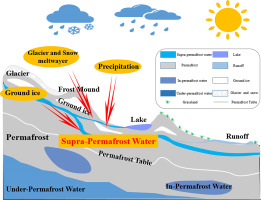当前位置:
X-MOL 学术
›
Sci. Total Environ.
›
论文详情
Our official English website, www.x-mol.net, welcomes your
feedback! (Note: you will need to create a separate account there.)
The sources of supra-permafrost water and its hydrological effect based on stable isotopes in the third pole region.
Science of the Total Environment ( IF 8.2 ) Pub Date : 2020-01-25 , DOI: 10.1016/j.scitotenv.2020.136911 Zong-Jie Li 1 , Zong-Xing Li 2 , Xin-Jian Fan 1 , Yu Wang 1 , Ling-Ling Song 3 , Juan Gui 2 , Jian Xue 2 , Bai-Juan Zhang 2 , Wen-De Gao 2
Science of the Total Environment ( IF 8.2 ) Pub Date : 2020-01-25 , DOI: 10.1016/j.scitotenv.2020.136911 Zong-Jie Li 1 , Zong-Xing Li 2 , Xin-Jian Fan 1 , Yu Wang 1 , Ling-Ling Song 3 , Juan Gui 2 , Jian Xue 2 , Bai-Juan Zhang 2 , Wen-De Gao 2
Affiliation

|
The sources of supra-permafrost water and its hydrological effects were studied, based on the presence of stable isotopes in 562 samples collected in different ablation periods from the source regions of the Yangtze River. The δ18O (δD and d-excess) values for the initial ablation, ablation, and end ablation periods were -10.18‰ (-71.39‰ and 10.08‰), -12.14‰ (-85.58‰ and 11.51‰) and -11.50‰ (-78.75‰ and 13.23‰), respectively. The order of the slopes for the supra-permafrost water evaporation lines from the different ablation periods was initial ablation (IA) > ablation (A) > end ablation (EA). An anti-altitude effect is documented here, for a specific altitude range, in what is believed to be the first record of such an occurrence. Outside of that range, clear altitude effects were apparent. We have been able to show that supra-permafrost water was mainly recharged by atmospheric precipitation, ground ice, and glacier and snow meltwater, in the initial ablation and end ablation periods, and contributions from glacier and snow meltwater were mainly concentrated in higher altitude regions. In contrast, in the ablation period, supra-permafrost water was mainly recharged by atmospheric precipitation and ground ice. The contributions of precipitation to supra-permafrost water were 78.79%, 85.47%, and 82.99% in the initial ablation, ablation, and end ablation periods, respectively. The contributions of ground ice to the supra-permafrost water were 14.05%, 14.53%, and 11.94%, respectively, while contributions of glacier and snow meltwater were 7.15% and 5.07% in the initial and end ablation period. For the initial ablation, ablation, and end ablation periods, contributions from atmospheric precipitation to the supra-permafrost water were 85.47%, 86.86%, and 86.84%, while contributions from ground ice were 14.53%, 13.14% and 13.16%, respectively.
中文翻译:

基于第三极区稳定同位素的超多年冻土水源及其水文效应。
基于长江源区不同消融时期采集的562个样品中存在稳定同位素,研究了超多年冻土水的来源及其水文效应。初始消融期,消融期和结束消融期的δ18O(δD和d-过量)值分别为-10.18‰(-71.39‰和10.08‰),-12.14‰(-85.58‰和11.51‰)和-11.50‰(-) -78.75‰和13.23‰)。来自不同消融时期的超多年冻土水蒸发线的斜率顺序为初始消融(IA)>消融(A)>结束消融(EA)。在此记录了针对特定海拔范围的反海拔效应,据信是这种情况的第一笔记录。在该范围之外,明显的高度影响显而易见。我们已经能够证明,在多年消融初期和消融期中,多年冻土水主要是由大气降水,地冰,冰川和雪融水补给的,而冰川和雪融水的贡献主要集中在较高海拔地区。相比之下,在消融期,多年冻土水主要通过大气降水和地下冰层补给。在初始消融,消融和结束消融期间,降水对超多年冻土的贡献分别为78.79%,85.47%和82.99%。在开始和结束消融期间,地冰对上多年冻土的贡献分别为14.05%,14.53%和11.94%,而冰川和融雪水的贡献分别为7.15%和5.07%。对于最初的消融,
更新日期:2020-01-26
中文翻译:

基于第三极区稳定同位素的超多年冻土水源及其水文效应。
基于长江源区不同消融时期采集的562个样品中存在稳定同位素,研究了超多年冻土水的来源及其水文效应。初始消融期,消融期和结束消融期的δ18O(δD和d-过量)值分别为-10.18‰(-71.39‰和10.08‰),-12.14‰(-85.58‰和11.51‰)和-11.50‰(-) -78.75‰和13.23‰)。来自不同消融时期的超多年冻土水蒸发线的斜率顺序为初始消融(IA)>消融(A)>结束消融(EA)。在此记录了针对特定海拔范围的反海拔效应,据信是这种情况的第一笔记录。在该范围之外,明显的高度影响显而易见。我们已经能够证明,在多年消融初期和消融期中,多年冻土水主要是由大气降水,地冰,冰川和雪融水补给的,而冰川和雪融水的贡献主要集中在较高海拔地区。相比之下,在消融期,多年冻土水主要通过大气降水和地下冰层补给。在初始消融,消融和结束消融期间,降水对超多年冻土的贡献分别为78.79%,85.47%和82.99%。在开始和结束消融期间,地冰对上多年冻土的贡献分别为14.05%,14.53%和11.94%,而冰川和融雪水的贡献分别为7.15%和5.07%。对于最初的消融,











































 京公网安备 11010802027423号
京公网安备 11010802027423号